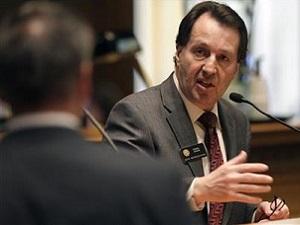Archive for March 26th, 2018
Sen. Dan Kagan Emerges as Defender of PERA
Posted by Joshua Sharf in Colorado Politics, PERA on March 26th, 2018

In Friday’s debate on SB200, the PERA reform bill, Sen. Daniel Kagan (D-Cherry Hills) emerged as the floor leader of those fighting to defend the current system. Neither his positions nor his prominence on this issue should entirely be a surprise to observers.
Kagan’s district isn’t particularly left-wing: it’s got a 32000 – 27000 Democrat-to-Republican registration advantage, but also has 35,000 Unaffiliated voters. Kagan won his race against Republican Nancy Doty 53% – 47% in 2016, running slightly behind Hillary Clinton, who got 56% of the three-way vote among herself, Donald Trump, and Libertarian Gary Johnson. Located in suburban Denver, it’s a battleground district, but because of its loction also has a lot of PERA members and retirees.
Kagan reliably votes the Democratic line and has since his time in State House of Representatives, but has a way of conducting himself with civility and generally respects even hostile witnesses who come before his committees. The plummy British accent born of a well-to-do aristocratic upbringing probably doesn’t hurt as a public face, either.
On Friday, Kagan proposed three separate amendments, all of which could well have been written by the unions. The first would have restored an increase in the employer contribution, a 1.5% increase as compared with the 2.0% increase that was amended out in the Finance Committee. He used the traditional phrases about “shared sacrifice,” but also noted that the SAED enacted in 2006 was supposed to come from money from foregone raises, claiming that the nominal current 20.15% overstates the actual employer contribution.
This is an argument rejected by both the governor’s office and even PERA itself, whose former executive director, the late Greg Smith, testified before committee that it was his impression that school boards around the state were eating the SAED themselves rather than taking it out of teacher pay.
Next, he moved an amendment to raise the COLA cap from 1.25% to 1.75%, although he didn’t speak to that amendment.
Finally, he proposed L-013, comprehensively different plan altogether. These sorts of amendments are called “strike-through” amendments because they strike-through the whole of the bill, seeking to replace it with something else. In this case, the “something else” would restore the employer contribution to 1.5%, lowered the increase in the employee contribution to 1.5%, capped the COLA at 1.75%, increased the Highest Average Salary calculation from 3 years to 5 years (as opposed to the 7 in the bill), rescinded the increase in the retirement age, kept the calculation on net pay rather than gross pay, and prevented the expansion of the DC plan availability to all employees.
He defended this proposal by arguing that the plan’s actuaries confirmed that, according to their assumptions, it would put PERA on a path to 100% funding in 30 years. He claimed that PERA was not in “crisis” as in 2010, but did lack “resiliency,” especially since the adoption of more “conservative” assumptions. The language here is important. The term that the PERA Board would use for its November 2016 revisions in the expected rate of return and mortality tables is “realistic,” but this is incorrect – they are more conservative, and still far too optimistic. It is those assumptions that the actuaries are operating under.
He also derided the expanded DC plan availability as a “poisoned chalice,” that most PERA members rejected in favor of the shared responsibility and pooled resources of a DB plan that would always be there for people. I think it should be obvious to all but the most blind observer that the experience of the last 20 years shows that, absent continual adjustments, benefit cuts, and increased taxpayer contributions, the DB plan will not “always be there.”
Debate on this amendment – backed by the unions – will continue Monday morning when the Senate reconvenes.



